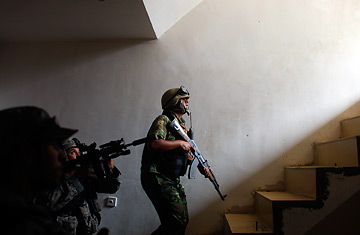
Iraqi military police, along with soldiers of 1st Squad, 4th Cavalry Regiment of the 1st Infantry Division, warily climb stairs in an abandoned house during a search June 17, 2007 in the tense Dora neighborhood of Baghdad, Iraq.
Fred Kagan, the man widely seen as the "architect" of the military surge in Iraq, sees signs of progress but warns that September is too early to make a final decision about how well it has achieved its goals. Instead, in an interview with TIME.com, Kagan recommended waiting until the end of the year before judging the operation's success. Even then, he added, it might be some months before Iraqis make the political compromises necessary to bring lasting stability to the country.
Kagan, the American Enterprise Institute and former West Point professor, was not the lone architect of the surge. Military planners took Kagan's idea for a more muscular counterinsurgency effort by U.S. forces in Baghdad, which he originally laid out last fall in an article in the Weekly Standard,and crafted something that in some ways is more ambitious than what he envisioned. But he certainly laid the conceptual foundation for the surge, and with that in mind, TIME.com spoke with him last week to get a progress report.
Like a lot of Administration supporters, Kagan sees both promise and peril in the coming months. He does not expect much clarity in the military situation by September, the date members of both parties increasingly cite as a make-or-break moment of the Administration in Iraq. Last week, hoping to quell expectations, White House officials sought to play down the significance of the September checkpoint, and Kagan echoed those cautionary words.
When Kagan first proposed the enhanced U.S. operation last fall, he envisioned a larger number of troops, ferreting out al-Qaeda and troublesome militias inside the capital city in order to create what he called the space to permit the struggling factions inside Iraq to work out their differences politically. Kagan is a little alarmed now that some people expect the political issues to be resolved while the fighting continues. "The political stuff comes later," he said, perhaps not until next year, after the violence has abated.
Kagan, who works out of a modest office at the conservative American Enterprise Institute in downtown Washington, said he continues to think that the military portion of the surge will require until the end of the year before there is enough calm to get the various Iraqi factions to begin to sort out their differences on power and revenue sharing. He called the September report to Congress by the Administration little more than a progress report.
Walking a reporter through what he believes to be the situation on the ground, Kagan unrolled two maps of greater Baghdad and delivered a before-and-after briefing on the surge. On the positive side of the ledger, Kagan said he saw three developments since the roughly 30,000 additional troops went into position in and around the Iraqi capital.
First, Kagan claims there has been a notable shift in attitudes among Sunni factions toward the U.S. and against al-Qaeda. Kagan ticked off a number of neighborhoods where local Sunni leaders have joined forces with U.S. troops to attack al- Qaeda cells. Kagan called that development, which he said he did not foresee, "a huge thing."
Second, he said there has been a drop in sectarian violence since U.S. forces increased their numbers in the Iraqi capital. He noted that the trend line for violence before the surge was pointing steeply up. Now, he said, that trend has not only leveled off but has dropped. "The question before was whether the civil war could be slowed," said Kagan. "Now the question is, can we end it?"
Third, Kagan saw progress in an unlikely quarter: the Iraqi Army. He claimed that those forces are increasing in professionalism and number.
Not everyone agrees with those claims. Pentagon officials recently told Congress that many Iraqi units are operating at only partial strength and that their numbers dwindle with each successive rotation through Baghdad. And while sectarian violence is lower than it was before the surge, there has been a spike upward lately. U.S. casualties, meanwhile, are rising. And there is widespread agreement that other Iraqi security forces, notably the police, are infiltrated by insurgents.
While predicting a violent summer, Kagan said the violence should "start to go down" in a few months. He does not expect it to be over by September, but said there should be visible trends in that direction. He admitted, however, that the insurgents get a vote in how this unfolds as well.
He said that he was looking for more Sunni leaders to reach out to U.S. forces in the coming months, and for a continued weakening of the Shi'a militias.
But none of these is guaranteed, he admitted, and he warned of possible developments that could be a harbinger of failure. A "spectacular attack by al-Qaeda" could spark a wider spiral of violence that would be hard to extinguish, he said. "They have tried it before, and they will try it again." He also fears a significant increase in Iranian support for those fighting U.S. forces. Finally, he noted that the shaky government of Nouri al-Maliki could just implode.
While that might not end the cause of progress in Iraq, Kagan said, it could lead to a breakdown in political support for the war effort in Washington.
